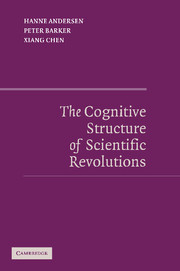Book contents
- Frontmatter
- Contents
- List of Figures
- Acknowledgments
- The Cognitive Structure of Scientific Revolutions
- 1 Revolutions in Science and Science Studies
- 2 Kuhn's Theory of Concepts
- 3 Representing Concepts by Means of Dynamic Frames
- 4 Scientific Change
- 5 Incommensurability
- 6 The Copernican Revolution
- 7 Realism, History, and Cognitive Studies of Science
- References
- Index
4 - Scientific Change
Published online by Cambridge University Press: 18 July 2009
- Frontmatter
- Contents
- List of Figures
- Acknowledgments
- The Cognitive Structure of Scientific Revolutions
- 1 Revolutions in Science and Science Studies
- 2 Kuhn's Theory of Concepts
- 3 Representing Concepts by Means of Dynamic Frames
- 4 Scientific Change
- 5 Incommensurability
- 6 The Copernican Revolution
- 7 Realism, History, and Cognitive Studies of Science
- References
- Index
Summary
In Chapter 2 we gave an account of concepts and conceptual structures based on family resemblance. We showed that on this account possession of a conceptual structure implies knowledge of ontology, as objects not belonging to any of the known similarity classes are assumed not to exist. Likewise, we showed that through the relations of similarity and dissimilarity, possession of a conceptual structure implies knowledge of regularities, that is, expectations of the different situations that nature does and does not present.
In Chapter 3 we have seen how conceptual structures of the kind introduced by Kuhn may be represented by dynamic frames, a form of representation developed in cognitive psychology and independently supported by empirical research. Frames not only accommodate the most important features of Kuhn's account, such as family resemblance, but may also be used to represent graded structure, the most important empirical phenomenon documented by studies of categorization supporting the reality of family-resemblance categories. The frame account allows us to display details of conceptual structures that are otherwise difficult to examine, such as the patterns of attribute-value sets that characterize concepts, and it allows us to locate constraints between elements of the structure that correspond to knowledge of ontology and knowledge of regularities.
We have already suggested a developmental perspective: a particular conceptual structure is always given by the preceding generation, which passes it on to the next.
- Type
- Chapter
- Information
- The Cognitive Structure of Scientific Revolutions , pp. 65 - 103Publisher: Cambridge University PressPrint publication year: 2006



